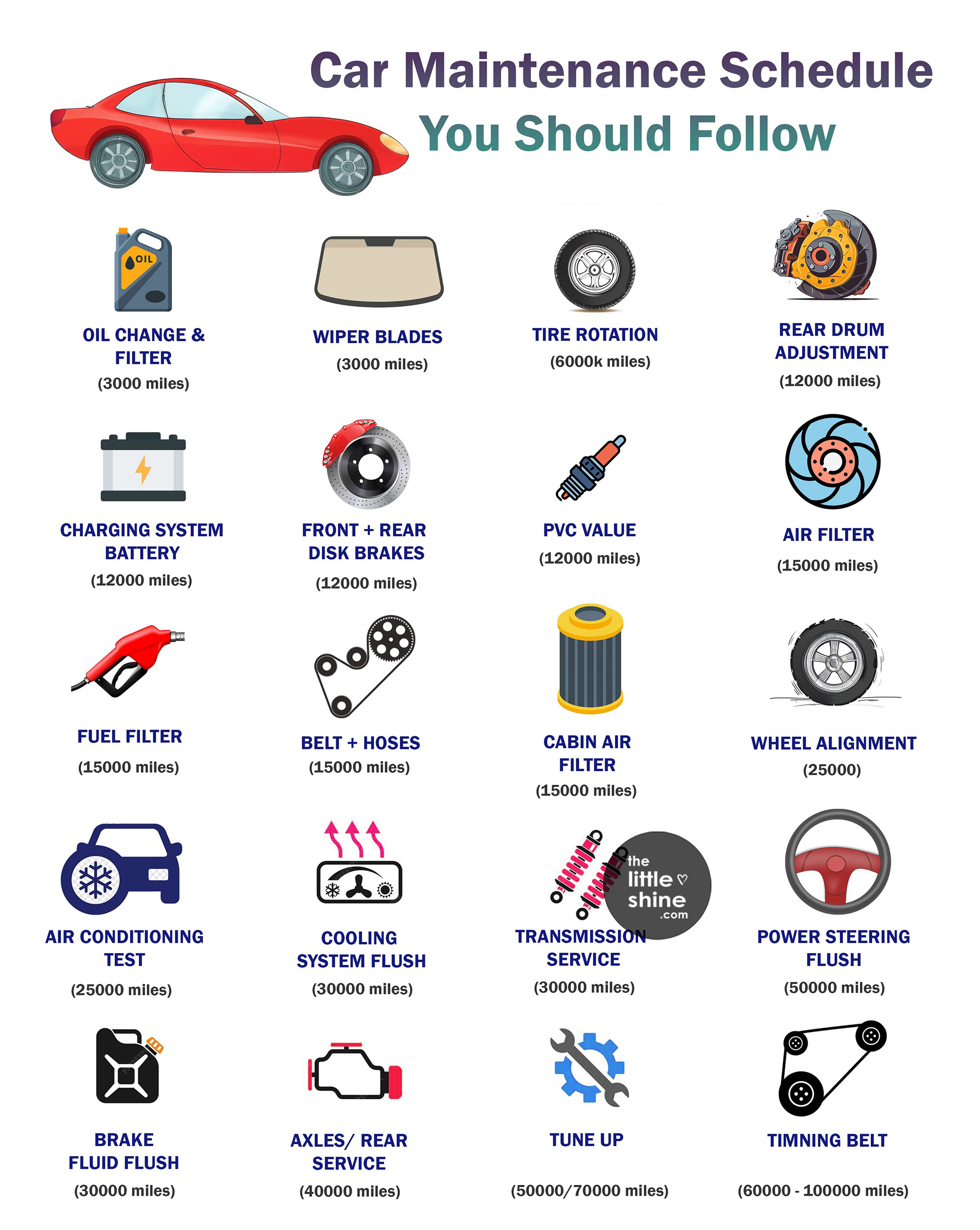Many of us own cars and there are some of us who own even two or three cars as well! But the question remains is – how much do you know about car care?

Yes, car care includes checks, tests and servicing of the different parts of the car from the air conditioning, wiper blades, oil, coolant, brakes, tires and the list goes on. But, how often do these checks need to be done? Once in how many miles should these checks be done?
Well, let’s talk about everything you need to know about a car maintenance schedule in this article!
Car Maintenance Schedule
Here’s an ideal car maintenance schedule you should follow to do checks, tests and servicing once your vehicle has completed a certain number of miles. Check it out below.
1. Oil Change & Filter – 3,000 miles
Benefits: Reduced engine heat, better fuel efficiency, longer engine life
2. Wiper Blades (check) – 3,000 miles
Benefits: Improved visibility, better operation, safety while driving
3. Tire Rotation – 6,000 miles
Benefits: Extended tire life, safety, better mileage
4. Front + Rear Disc Brakes – 12,000 miles
Benefits: Safety, better effectively, smoother braking
5. Rear Drum Adjustment – 12,000 miles
Benefits: Better functioning and smoother operation
6. Charging System Battery – 12,000 miles
Benefits: Safe operation and checking for issues
7. PVC Valve (check) – 12,000 miles
Benefits: To control emissions, improve oil life, engine cleanliness
8. Fuel Filter – 15,000 miles
Benefits: Improved fuel flow, engine longevity, reduced breakdowns, reduced contaminants
9. Air Filter (check) – 15,000 miles
Benefits: Improved air quality, fuel economy
10. Timing Belt – 60,000/100,000 miles
Benefits: Ensures vehicle’s reliability
11. Wheel Alignment – 25,000 miles
Benefits: Better braking and better tire life
12. Air Conditioning Test – 25,000 miles
Benefits: Better air quality, more fuel economy
13. Fuel Injection Service – 25,000 miles
Benefits: Improved engine performance, reduced emissions
14. Transmission Service – 30,000 miles
Benefits: Better fuel economy, better gear functioning
15. Cooling System Flush – 30,000 miles
Benefits: Prevents corrosion, prevents overheating
16. Brake Fluid Flush – 30,000 miles
Benefits: Prevents corrosion, better braking performance
17. Axles/Rear Service – 40,000 miles
Benefits: Safety, better performance, reduce repair costs
18. Power Steering Flush – 50,000 miles
Benefits: Better steering performance, better steering life
19. Tune-Up – 50,000/70,000 miles
Benefits: Better fuel efficiency, better car performance, extended vehicle life
20. Belt + Hoses (check) – 75,000 miles
Benefits: Safety, enhanced car performance
General Benefits of Car Maintenance
- Helps increase the car’s lifespan: Regular and up-to-date car maintenance helps extend the lifespan of your car. When a car is well-maintained, it runs well, without the need of any repair on a regular basis, while reducing the ownership cost on an overall basis.
- Ensures better traveller safety: A well-maintained car will ensure utmost driver and passenger safety. A poorly maintained car can have wear and tear of car parts, poor engine functioning, lack of brake maintenance etc.
- Helps reduce breakdown risks: When a car is well-maintained, it can reduce the risk of having a breakdown (especially during long-distance travel).
- Has a better resale value in the market: Cars that are well-maintained, have a better and higher resale value, as compared to a poorly maintained car. It will sell quicker and for a higher price in the second-hand car sale market.
- The car will have better efficiency: Driving a car that is well-maintained, can give your car better efficiency and also it will ensure optimum performance of the vehicle.
- Ensures cost-effectiveness (including fuel-efficiency): Cars that are well-maintained have better fuel efficiency and are also cost-efficient.
